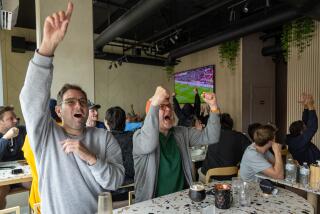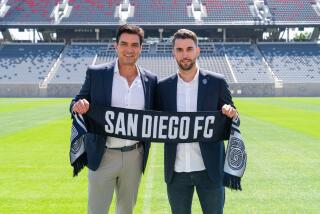Creating Soccer Teams of Their Own
Genaro Cortez didnât set out to build a soccer league. The 41-year-old carpenter just wanted to kick a ball around with his six sons in Lanark Park, once a notorious hangout for drug dealers in Canoga Park.
But there among cruising cars and blaring stereos, the first Cortez family games drew more than casual interest. Kids started asking to play. Lots of them.
Three months later, Cortez found himself in charge of a soccer league with more than 300 players and 21 teams. While national youth soccer leagues attract sponsors like Nike, Cortez pleads for donations from burrito trucks and carnicerias.
His makeshift league is more than just a testament to the growing popularity of the sport. It is part of a grass-roots movement being felt at soccerâs top ranks, springing from some of its most passionate and, some argue, neglected fans: working-class Latinos.
âIf youâre a Latino person, youâve got soccer in your blood,â said Rene Miramontes, of the U.S. Soccer Federation.
Cortezâs league and others are emerging because mainstream soccer organizations and public facilities are âgeared toward the privileged,â said Bart Brown of the L.A. Soccer â94 Foundation, which was created by World Cup organizers to better integrate the sport. âThere is a separate and unequal system in place.â
As a result, Brownâs group and others are making first-time efforts to promote talent among Latino players in disadvantaged neighborhoods throughout Los Angeles. There are also increasing efforts to use soccer to steer inner-city kids out of trouble.
At Lanark Park and other city facilities, parents are not waiting for help. They have been creating shoestring soccer leagues for youngsters who cannot afford to join more established organizations. These rookie organizers are finding they must compete with more established sports, such as softball and youth football, for space at city parks.
Cortez, who played soccer in his hometown of Guadalajara, funds his league largely from his own pocket. He buys cheap jerseys in Tijuana, and his players sometimes show up in tattered tennis shoes.
He says the league unites two passions--soccer and helping children.
âHere you have an opportunity with those who are coming up, with children,â he said in Spanish.
He was standing in blistering heat at a recent evening practice. All around him, small boys romped with soccer balls.
Cortez spends nearly every night at the park. He is joined by neighborhood parents so devoted that some come straight from jobs in local factories, coaching in blue company-issue coveralls.
Nearly all the families involved are Latino. Most live in apartments next to the park.
Besides diversion, soccer is also a cultural link between foreign-born parents and their children.
Many families are from countries where soccer is a national obsession. Fathers describe their younger glory days playing in Mexico, Peru and El Salvador.
For first-generation Americans, soccer provides âa way to participate in American culture that doesnât take children farther from their parents,â said Mike Woitalla, senior editor of Soccer America, a Bay Area weekly.
It is also a cheap way to keep kids off the streets, said Jose Garcia, a hardwood floor contractor who runs the United Nations Soccer League at Valley Plaza Park in North Hollywood. The league has grown to 2,000 kids in two years. âOne ball is good for twenty kids,â he said.
One of the cityâs oldest independent groups is the California Soccer League, based in East Los Angeles. It is a low-cost youth program serving about 4,000 kids, â99% Latino,â said president Reyes Oliveras.
These independent leagues are a world apart from the more established American Youth Soccer Organization (AYSO), which began its season this weekend, and the California Youth Soccer Assn.-South.
The two groups are to soccer what Little League is to baseball, and together claim more than 3 million soccer players nationwide. Players are âpredominantly urban/suburban white upper-class,â said Ric Fonseca, a CYSA soccer coach and co-founder of the Latin American Coaches Assn., a group formed recently to promote integration of the sport.
Fonseca is starting a new league in the Pico corridor area of West Los Angeles that represents one of the CYSAâs first efforts to reach out to disadvantaged Latinos.
Neither the AYSO nor the USYSA keeps statistics on minority participation, but USYSA spokeswoman Kit Simeone acknowledged many children canât afford to join.
AYSO officials said that although many Latinos play in their leagues in California, the ethnic split in soccer âis generally accepted and acknowledged, though itâs nothing anyone is proud of,â said one official with the group, who asked not to be identified.
Both groups have made efforts in recent years to include disadvantaged children.
AYSO has three affiliates for low-income children in Watts, Inglewood and near downtown.
But mostly, the organizations reach few needy youngsters.
The West Valley Soccer League, a CYSA affiliate near Lanark, costs $95. That fee covers about five to 10 scholarships a year among the leagueâs 1,000 players.
The Lanark parents said those steep fees are the main reason they hadnât signed up their children.
Seeking a sports program she could afford, âI found there wasnât anything anywhere,â said one Lanark parent, Irma Gonzales. One league she called cost $200, she said.
There is no CYSA-South or AYSO league in Lanark Park. An AYSO group at nearby Winnetka Park costs $80 per season. AYSO costs vary, but $50 to $100 is typical, and some elite CYSA-South leagues cost thousands.
Cortez, by contrast, charges $35 to those who can afford it--well short of what it costs to pay for field rentals and uniforms, he said.
Increasingly, amateur and professional soccer groups are seeking to bridge ethnic and economic gaps in the sport.
Elsewhere, âsoccer is the peopleâs game . . . but here itâs geared mainly to middle- and upper-middle-class people,â said Octavio Zambrano, assistant coach of the L.A. Galaxy, the cityâs professional soccer team.
The issue is more pressing because itâs become clear that Latinos are the core of the fan base for professional soccer, he said. âThose people are seeing soccer take hold in this country, but they are not seeing many of their own reach this level.â
Help for youth leagues such as Cortezâs has been slow to come, though.
Much of the new outreach efforts are focused on demonstration teams, clinics and tournaments aimed at showcasing Latino talent for college and professional recruiters, said Rene Miramontes, recently hired by the U.S. Soccer Federation to increase Latino representation in the sport.
These could help Latinos advance economically, he said: âIâm an example. I grew up in the barrio in San Diego, and went to college on a soccer scholarship. I would have been happy to stay in my own little world and speak Spanish all my life. But soccer was my vehicle out.â
But some volunteer organizers say they are more concerned with simply keeping their leagues afloat so neighborhood kids have a chance to play.
One big problem is field space.
At Lanark Park, Cortez is frustrated that he canât get more fields because of competition with adult leagues that can afford higher fees. Park officials have not committed to renewing his $1,260 lease when it expires in January.
Eric Rose, district director for Councilwoman Laura Chick, said: âItâs a balancing act, to provide room for soccer and other activities.â
Parks citywide are scrambling to keep up with the rising demand for soccer fields, said Ann Kerman, of the Department of Recreation and Parks.
Cortez is indignant that his league may be ousted by flag football in January. Soccer is what neighborhood kids want to play, not football, he says.
Zambrano agreed. Those in charge of recreational sports âneed to wake up to the fact that there is a new generation of Americans that loves this game,â he said.






